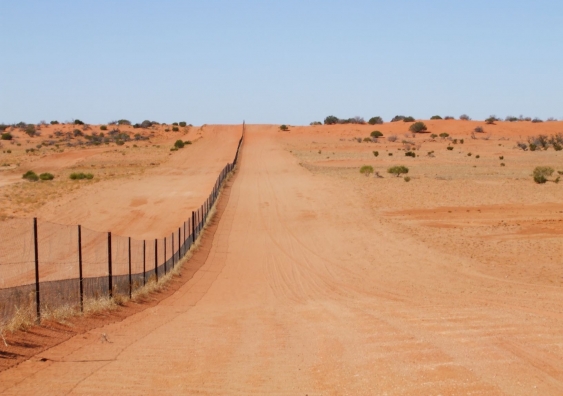
Dingoes — those scruffy wild dogs on the Australian Outback usually portrayed as a nuisance? It turns out they’re good for the ecosystem, according to a new study from the University of New South Wales Sydney. The study, published in Landscape Ecology, looked at 32 years of satellite data from NASA and the United States Geological Survey’s Landsat program. Previous dingo research has been site-based or relied on drone imagery. This satellite data has made landscape-wide analysis possible for the first time and it revealed something very interesting.
A time-lapse video of satellite images posted on UNSW’s YouTube channel reveals a pronounced straight line along the NSW state border where a large part of the Dingo Fence runs. Vegetation inside the fence where there are no dingoes had poorer long-term growth than vegetation in areas with dingoes.
The Dingo Fence was built in the 1880s to protect livestock; it spans parts of Queensland, New South Wales, and South Australia, and at 5,600 kilometers long, it’s one of the longest structures in the world and has been extremely successful at keeping dingoes out. But while this might keep livestock and other fauna from getting chomped on by hungry dingoes, it’s not so great for the local flora.
In this data compilation, we can see the long-term effects of removing dingoes from the local ecosystem, and we can see those long-term effects from space. That’s right, the environmental impact of removing dingoes is visible from space. The Great Wall of China isn’t even visible from space!
Professor Mike Letnic, senior author of the study and researcher at UNSW’s Centre For Ecosystem Science, said in an interview: When dingoes are removed, kangaroo numbers increase, which can lead to overgrazing. This has follow-on effects to the entire ecosystem.
Those follow-on effects are a process called a trophic cascade, which in this case means fewer dingoes lead to an increase in kangaroo populations, which leads to overgrazing, which reduces vegetation and damages the quality of the soil, which causes even less vegetation, which hinders the survival of smaller animals. This goes to show how precariously connected everything on our planet is.
According to Professor Letnic, the fence’s sharp divide between dingo and non-dingo areas provides a rare opportunity to observe the indirect role of an apex predator and the far-reaching effects of removing apex predators from an ecosystem. And this was all made possible by satellite data.
Satellite imagery usually only looks at photosynthesizing vegetation, meaning plant life that’s visibly green. But the UNSW researchers used a model to factor in non-green vegetation such as shrubs, dry grasses, twigs, branches, and leaf litter. Stuff that’s important to a desert ecosystem like the one found in the Australian Outback. The model was developed by the Joint Remote Sensing Research Program, a collaborative group that includes UNSW.
According to lead author Dr. Adrian Fisher, a remote sensing specialist at UNSW, there were other contributing factors to the difference in vegetation such as differing rainfall patterns and land use, but the dingoes definitely played a central role. Dr. Fisher went on to say: Our study is an example of how satellite technology can be used in big picture environmental research.
They hope to next use the Landsat images, which are freely available for download, to study how different amounts of vegetation can influence bushfire frequency.
While this dingo study can be seen as yet another example of how human-made structures are negatively impacting the planet, it also shows that even some scruffy wild dogs can play an important role in making the earth better for everyone.
More Information
UNSW-Sydney press release
“Remote sensing of trophic cascades: multi‐temporal Landsat imagery reveals vegetation change driven by the removal of an apex predator,” Adrian G. Fisher et al., 2021 February 11, Landscape Ecology




 Join the Crew!
Join the Crew!
 Escape Velocity Space News
Escape Velocity Space News
0 Comments